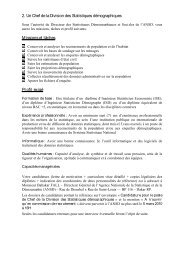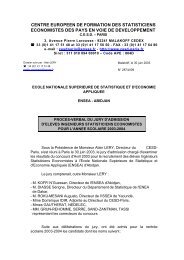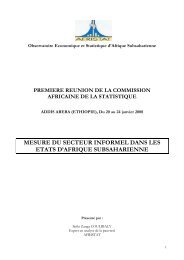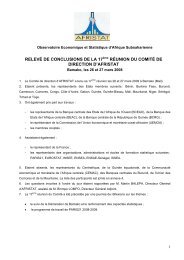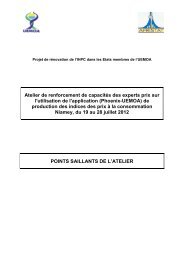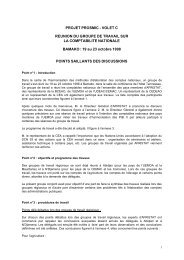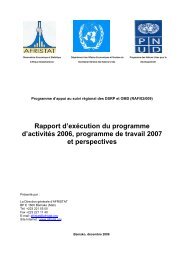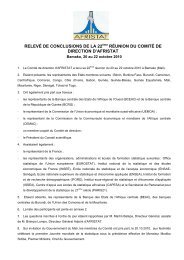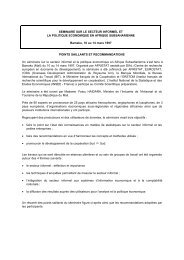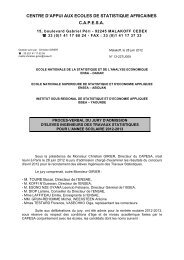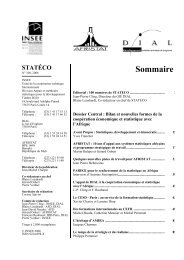Global Purchasing Power Parities and Real Expenditures - Afristat
Global Purchasing Power Parities and Real Expenditures - Afristat
Global Purchasing Power Parities and Real Expenditures - Afristat
Create successful ePaper yourself
Turn your PDF publications into a flip-book with our unique Google optimized e-Paper software.
Methodology: Calculating PPPs 159system. Major advantages of using a single price vector arethat the process is a straightforward multilateral one <strong>and</strong> nosecond stage of processing is required because the volumesare transitive; they are also additive, which is a useful attributefor some analyses.The disadvantage of the GK method is that the averageprices in the price vector are weighted using quantityweights from all countries in the region. The result is thatthe prices of larger countries <strong>and</strong> countries that have a relativelyhigh level of expenditure will have a greater weightthan those of the smaller countries. In other words, theprices observed in the smaller <strong>and</strong> lower-income countriestend to deviate more from the average prices of the region(that is, those in the price vector) than those of larger <strong>and</strong>of higher-income countries, which have a greater influenceon the average prices calculated. One consequence of thisweighting pattern is that the volumes estimated for lowerincomecountries tend to be higher than would have beenthe case if a weighting pattern were used that more closelymatched the actual price structure in the lower-incomecountries. This bias is referred to as the “Gerschenkroneffect.”To reduce the extent of the bias caused by the Gerschenkroneffect, the approach used in the Africa regionwas a variation of the GK approach known as the “Iklémethod.” The Iklé weights are based on country expenditureshares, rather than on country quantity weights. Asa result, the weights are more evenly distributed amongcountries <strong>and</strong> are not so heavily dependent on the higherincome<strong>and</strong> larger countries as in the GK method. The Iklémethod minimizes the Gerschenkron effect, although itdoes not eliminate it completely. More important, it providesadditivity.Eurostat-OECD has used the EKS method since 1990.In the 2005 ICP, Africa used the Iklé method, while all theother regions used an EKS approach. Africa preferred anadditive method, which was considered important in theiranalysis.Combining Regional Results witha <strong>Global</strong> Comparison: The RingComparisonThe 2005 ICP was organized on a regional basis, partly foroperational reasons <strong>and</strong> partly because economies withina geographic region are more likely to be similar to eachother than to economies in other parts of the world. Thelatter point means that more robust results are likely withina region than would be the case if all economies in theworld were combined in a single, worldwide comparison.For example, within a regional comparison, the productlists can be focused on a smaller range of products, enablingeconomies to price a large proportion of them. At thesame time, the characteristics of the products can be moretightly specified, so quality differences are likely to be lesssignificant.To produce global estimates, regional results must bematched with each other. Two alternative methods wereconsidered for linking regions in the ICP. One was to nominate“core” or “bridge” countries, which would have toparticipate in two regional comparisons, providing a linkbetween that pair of regions. The other was to select a groupof countries, a few from each region, that would participatein a separate <strong>and</strong> parallel worldwide comparison organizedspecifically to provide a link between regions.With one exception, the second alternative was adoptedfor the 2005 ICP. This has become known as the “ring comparison”because of the way in which it worked to determinethe PPPs between different global regions. The ringcomparison was a much-reduced global ICP comparisonin which transitive PPP relationships, at the basic-headinglevel <strong>and</strong> above, were established between regions ratherthan between individual economies in each region. Intotal, 18 ring countries conducted special price collectionsusing a global product list to enable these relativities to becalculated.The ICP’s Technical Advisory Group (TAG) recommendedthe ring comparison approach because it felt thatit would provide the most robust links between regions.The ICP global office was responsible for leading the ringcomparison work. It was developed in such a way thatproducts could be matched between ring countries in anypair of regions, thereby maximizing the usefulness of thedata collected.Whichever linking technique was used (that is, bridgecountries or the ring comparison), it would have been possibleto use either a single country or several countries fromeach region to link the regions together. It was not necessaryto include the same number of countries in eachregion, although obviously at least one country must beinvolved from each region. The bridge country approachwould have been simpler to implement, <strong>and</strong> it is less



